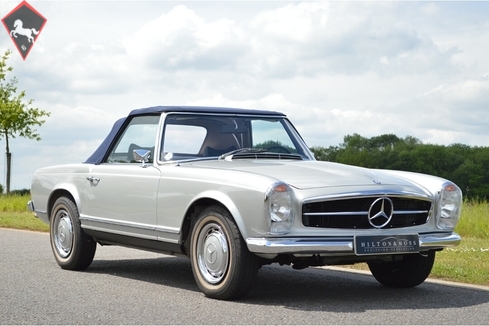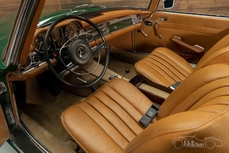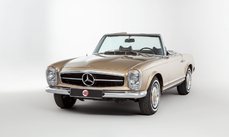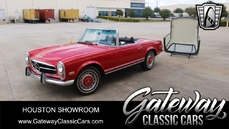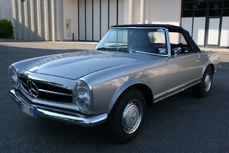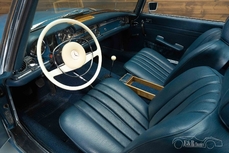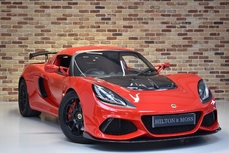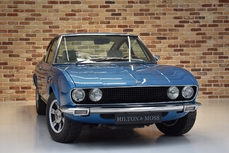Mercedes-Benz 280SL w113 PAGODA 1969
General description :
Deposit taken.
Having spent most of its life in the States, this 1969 Mercedes 280SL Pagoda was in a remarkably rust free state – one of the best we’ve ever seen, in fact.
Residing in a dry state meant the car was able to avoid the rust problems that often plague classic Mercedes of this era, and we were astonished by the originality of the shell. There were no signs of previous accident damage or previous welding, and even the smallest details were still correct to how they would’ve left the production line – the original seams and spot welds, for example, are still visible; details which are often masked by previous paintwork and body repairs. Taking all these original features into account meant it was quite possibly the best 280SL Pagoda shell we’d ever come across.
With the car’s previous owner having spent a considerable sum with us on a full body restoration, repaint in DB180 Silver, full conversion to European spec, new hood and partial interior re-trim, in addition to numerous smaller improvements throughout the car, we relished the opportunity to add it to our stock, as we know the car intimately. The restoration is fully documented with over 400 images, which will be supplied with the car.
Of course, to do a full colour change necessitated stripping the car down to a bare shell, and work could then begin to rectify the various dents and bodywork issues that were present across the car. Starting life in USA spec, the decision was made to delete the side markers and change the bumpers, headlights and tail lamps for European spec, in addition to fitting the all important chrome flashing underneath the numberplate. The boot floor was rusted through, so that was cut out and replaced with a new, genuine Mercedes-Benz replacement panel. The radiator and various engine bay components were painted satin black, and the fuel pump and injectors were overhauled. New rubber seals were fitted all round the body, in addition to a new windscreen, new headlamp units, new engine auxiliary belts and new water hoses. The wheels were refurbished and powdercoated, and new period correct, whitewall tyres fitted to them. After fitting new tyres, there would have been little point in leaving the braking system feeling lacklustre, so all 4 calipers were removed from the hubs and overhauled.
After re-fit, our attention then turned to improving things aurally. Despite these cars benefiting from a lovely sounding straight six engine, it was essential to be able to provide good quality music for those long drives. We carried out a custom installation of speakers and a retro look modern stereo, including trimming the speakers pods in blue leather to match the interior – it’s the little details that define a Hilton and Moss car.
A unique opportunity to purchase one of the most original and honest 280SL Pagodas on the road today, with bodywork having been carried out to an exceptionally high standard.
For any serious enquiries, please email *protected email*
https://hiltonandmoss.com/cars/mercedes-benz-280sl-pagoda/
1969 Mercedes-Benz 280SL w113 PAGODA is listed sold on ClassicDigest in Stansted by Hilton Moss for £124995.
Car Facts
Car type : Car Make : Mercedes-Benz Model : 280SL w113 Model Version : PAGODA Engine size : 0.0 Model Year : 1969 Sub type : Convertible Location : Stansted
Sold
Seller Information
Sold
People who viewed this Mercedes-Benz 280SL w113 also viewed similar Mercedes-Benz listed at ClassicDigest
Other cars listed for sale by this dealer
About Mercedes-Benz
In the annals of automotive history, the journey of Mercedes-Benz is a tale that unfolds with the ingenuity of its founding pioneers. In the year 1886, Karl Benz crafted the Benz Patent Motorwagen, a creation that would go down in history as the world's inaugural automobile. Unbeknownst to him, this moment marked the genesis of what would evolve into the most illustrious premium car manufacturer globally. The financial underpinning of this pioneering venture, interestingly, was provided by Karl Benz's wife, Bertha Benz, demonstrating a remarkable partnership that would set the tone for Mercedes-Benz's legacy.A parallel narrative emerged not far away, as Daimler-Motoren-Gesellschaft, founded by Gottlieb Daimler and Wilhelm Maybach, entered the scene. In 1901, they unveiled their automobile under the now-famous moniker "Mercedes," meaning "godsend" in Spanish. This name was bestowed upon the car at the behest of Emil Jellinek's daughter, the distributor for Daimler-Motoren-Gesellschaft. The wheels of innovation were set in motion.
Fast forward to 1926, a pivotal year that witnessed the merger of Daimler with Benz & Cie., culminating in the birth of Daimler-Benz. The amalgamation saw the adoption of "Mercedes-Benz" as the distinguished trademark for their automobiles, fusing the legacies of two visionary entities into one.
Contrary to perceptions of conservatism, the trajectory of Daimler-Benz unfolds as a chronicle of industry firsts. From the introduction of the honeycomb radiator to the float carburetor, and the pioneering implementation of four-wheel brakes in 1924, Daimler-Benz consistently pushed the boundaries of automotive innovation. The diesel-powered Mercedes-Benz 260 D in 1936 marked the inception of diesel engines in passenger cars. The iconic Mercedes-Benz 300SL Gullwing made history as the first car with direct fuel injection, albeit the Gutbrod's tiny 2-stroke engine can claim precedence.
Safety innovations became a hallmark, with Béla Barényi's patented safety cell design in the "Ponton"-models in 1951, featuring front and rear crumple zones. The W116 450SEL 6.9 saw the introduction of the Anti-Lock Brake system (ABS), another pioneering safety feature. From the first production airbags and beyond, the legacy of "firsts" continued to be etched into the fabric of Daimler-Benz.
Over its centennial journey, Mercedes-Benz has not merely produced cars but has sculpted automotive icons. The SSKL, 710 SSK Trossi Roadster, 770K Grosser, 540K Spezial Roadster, 300SL Gullwing, w100 600 Pullman, w111 280SE 3.5 Flachkühler, w113 230SL Pagoda, w109 300 SEL 6.3, and w201 2.3-16 Cosworth stand testament to the brand's commitment to engineering excellence.
The roaring Silver Arrows, or "Silberpfeile," including the W 25, W 125, W154, W165, and W196, created a legacy of dominance on the racetrack. These machines were not merely cars; they were expressions of precision, speed, and an indomitable spirit that left their competitors in the dust.
As Mercedes-Benz marches into the future, it does so not just as an automaker but as a custodian of a legacy, a torchbearer of innovation, and a beacon of automotive excellence. The road ahead is sure to witness the continued fusion of cutting-edge technology, timeless design, and an unwavering commitment to setting new standards in the world of automobiles.
One luminary figure who left an indelible mark was Béla Barényi, often heralded as the "father of passive safety" for his pioneering work in safety engineering. His patented safety cell design, featuring front and rear crumple zones, became a hallmark of Mercedes-Benz's commitment to occupant safety, setting new standards that reverberated throughout the automotive world.
Moving through the chronicles, the collaborative genius of Wilhelm Maybach, alongside Gottlieb Daimler, laid the foundation for Daimler-Motoren-Gesellschaft. Their innovations not only birthed the first Mercedes but established a culture of relentless pursuit of technological excellence that remains integral to Mercedes-Benz's DNA.
In the post-merger era of 1926, Ferdinand Porsche emerged as a prominent figure within Mercedes-Benz. His work on the Mercedes-Benz S-Type, a supercharged race car, garnered acclaim and set the stage for a legacy that extended far beyond the marque. Porsche's impact would later extend to his eponymous company, but his influence at Mercedes-Benz during those formative years was pivotal.
As the 20th century progressed, the legendary Rudolf Uhlenhaut emerged as a key figure. Uhlenhaut, an accomplished engineer and the driving force behind the iconic Silver Arrows, played a crucial role in Mercedes-Benz's dominance in motorsports. His engineering prowess and attention to detail were instrumental in creating some of the most formidable racing cars of the era.
In the latter half of the century, figures like Bruno Sacco, the head of design at Mercedes-Benz from 1975 to 1999, left an indelible imprint on the brand's aesthetic identity. Sacco's design philosophy, characterized by clean lines and timeless elegance, shaped iconic models like the W126 S-Class and the W201 190E, solidifying Mercedes-Benz's reputation for luxury and sophistication.
The narrative would be incomplete without acknowledging the contributions of engineers like Hans Scherenberg, whose leadership in the 1970s ushered in a new era of technological innovation at Mercedes-Benz. Scherenberg's tenure saw the development of groundbreaking technologies, including the Anti-Lock Brake system (ABS) and the introduction of airbags in production cars.
